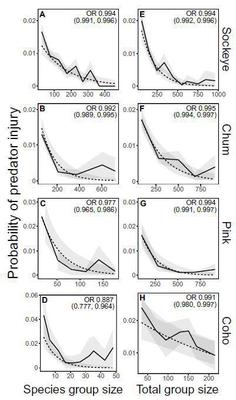Safety in numbers keeps Pacific salmon safe at sea
Grouping is ubiquitous across animal taxa and environments. Safety in numbers is perhaps the most cited reason for grouping, yet this fundamental tenet of ecological theory has rarely been tested in wild populations. We analyzed a multidecadal dataset of Pacific salmon at sea and found that individuals in larger groups had lower predation risk; within groups of fish, size outliers (relatively small and large fish) had increased predation risk. For some species, grouping decreased foraging success, whereas for other species, grouping increased foraging success, indicating that safety competition trade-offs differed among species. These results indicate that survival and growth depend on group size; understanding the relationship between group size distributions and population size may be critical to unraveling ecology and population dynamics for marine fishes.
Read the full article here: https://www.science.org/doi/full/10.1126/sciadv.abm7548
